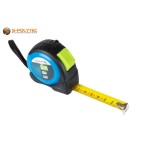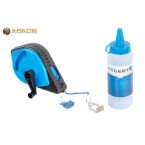
Cable stripping tool
Our cable stripping tool is suitable for stripping cable sheaths from electrical cables and cables with a sheath diameter of 8mm to 13mm as well as for coaxial cables and single conductors with a cross-section of 0.5mm2 up to 6mm2.
✓ Very easy handling
✓ Blades made from SK5 carbon steel
✓ For cable sheaths from Ø 8 to Ø 13mm
✓ For wires of 0.5mm2 up to 6.0mm2
✓ Also for RG-6 and RG-59 cables
✓ Non-slip handle
The multifunctional stripping tool is equally suitable for rigid and flexible electrical cables.
The item is in stock
Dispatch within 2 - 3 working days
- calculate the price
€12.90 / pc.
0,0690 kg / pc.
All prices include 19% VAT.
- Description
Stripping tool for cables, wires and single conductors
Blade made of SK5 steel ✓ Non-slip handle ✓ Also for aerial cables ✓
Our stripping tool from Högert is a multifunctional tool that is suitable for stripping cable sheaths from electrical wires and cables. The tool is suitable for all rigid or flexible cables with a sheath diameter of 8mm to 13mm. The solid SK5 carbon steel blades glide effortlessly through the cable insulation. Additional side-mounted blades with notches in different sizes are used for the precise stripping of individual wires and the stripping of RG6 and RG59 coaxial cables. The sharp, ground blades are precisely matched to the respective cable diameters and cross-sections so that the insulation is cut through but the aluminium or copper wire is not damaged.
The rubberised, ergonomically shaped handle has nubs and grooves to prevent slipping when stripping cables. The mechanical locking mechanism for safe storage is also studded and allows the stripper to be easily locked and unlocked with the thumb. A solid metal clip allows the tool to be attached to a belt, breast pocket or trouser pocket when not in use, so that it is quickly to hand when the next cable needs to be stripped or the individual wires need to be removed.
Features of the Högert cable stripper
The Högert cable stripper is a compact, handy tool for stripping electrical cables, flexible cables and individual wires and impresses with its outstanding manufacturing quality. The stripping tool meets the high demands of electricians who not only value a high-quality product, but also easy handling and reliable, damage-free stripping of cables. The ground blades are made of high-quality carbon steel, which is characterised by an enormous service life without losing its sharpness over time.
In addition to the blades positioned on the head side for stripping the outer sheathing of cables, the wire stripper has additional blades on the side with notches in various sizes. These are used to strip individual wires from a wire or cable. The nominal cross-section is easy to read on the plastic housing. The American size unit AWG (American wire gauge) is also stamped on the opposite side. The indentations, which correspond to the most common cross-sections in domestic installations, are cut in 0.5mm2, 1.0mm2, 1.5mm2, 2.5mm2, 4.0mm2 und 6.0mm2 increments for damage-free stripping of the individual wires. The two larger recesses, on the other hand, are intended for stripping the outer sheathing of RG59 coaxial cable and RG6 coaxial cable to expose the shielding. Between these and those for single conductors, there is a further notch for coaxial cables, which is intended for stripping the dielectric so that the inner conductor can be removed.
The multifunctional wire stripper has compact dimensions and a total length of 122mm and a diameter of approx. 25mm. This means that the useful tool fits in your pocket or toolbox. Thanks to a robust metal clip, the wire stripper can be conveniently attached to a belt or breast pocket so that it is always ready to hand when cables or wires need to be stripped. The housing is made of impact and shock-resistant plastic and has a rubberised grip surface, which ensures a pleasant feel and prevents slipping thanks to pronounced nubs over the entire surface. It can be operated with both hands, as the locking bar can be easily operated with either the left or right hand. The gripping surfaces on the blade side for the thumb are also recessed on both sides of the wire stripper and have a grooved surface for safe, ergonomic handling.
Use and handling of the cable stripper
The stripping tool is very easy to use. Two sharp blades on the front outside of the outer cable sheathing are used to cut into the insulation. The small locking mechanism is opened for this purpose. A small steel spring causes the stripper to open so that the cable can be inserted into the tool. The extent to which the cable should be stripped depends on the intended use. For cables that are routed directly out of the wall or ceiling, the tool can be positioned so that the plastic housing touches the wall so that only a very narrow edge of the cable sheathing remains. Inside flush-mounted appliance boxes or cavity wall boxes, the small tool can also be inserted deep into the box to strip as much of the sheathing as possible so that rigid insulation does not hinder the connection of light switches and sockets or insertion into the box.
The stripping process itself is carried out with two simple hand movements. Closing the cable stripper causes the blades to penetrate the cable sheath. By rotating the tool, the sheath of the cable is cut in a complete circle. Do not apply too much pressure so that the individual wires or their insulation are not also cut. The tool can now be opened again and removed from the cable. The cable sheath can now be easily removed. If the sheath has not been cut deep enough, it is usually sufficient to cut it completely at the pre-scored point with a slight bending movement.
NOTE: Avoid pulling down the cable sheath using the stripping tool. On the one hand, this can damage the blades due to the tight tensile load and, on the other hand, the sharp blades can damage the insulation of the individual cores.
To remove individual wires, for example to wire them with plug-in terminals, or to connect changeover switches, sockets, lamps or similar, the stripper has side-mounted blades with notches in the nominal cross-sections of the cable. This is printed on the outer sheath of most cables. A typical example is a NYM-J 3x1.5 electrical cable, which is one of the most common cables used in electrical installations. The grey cable with PVC sheathing contains three individual wires, which usually have black, blue and green/yellow wire insulation. Each of these individual wires has a nominal cross-section of 1.5mm2 so that the notch next to the corresponding labelling must be selected to strip the wire. After opening the stripper, the insulated single core is inserted into the lower notch to the desired depth (usually 5 - 7mm) and the tool is closed. A small twisting movement ensures that the sheathing is completely cut into so that it can be easily removed.
To attach F connectors to a coaxial cable so that it can be screwed into the satellite system or receiver, the antenna cable must be stripped in two steps. In the first step, the inner conductor is stripped. To do this, place the coaxial cable on the small, almost centred notch and press the stripping tool together so that the blades penetrate through the outer sheathing, the shielding and the inner insulation layer, the so-called dielectric. The cable should be positioned so that the inner conductor, which usually consists of a rigid copper wire, is centred over the notch. With a slight twisting movement of the tool, everything except the wire is cut in a circle so that the inner conductor is exposed by a short pull. In the second step, only the outer sheathing is removed so that the shielding underneath is stripped and a secure, conductive contact to the internal thread of the F connector is achieved. Depending on whether the cable type used is an RG6 or an RG59 coaxial cable, it must be inserted into the corresponding notch. These are labelled with an embossing next to the blade. Here too, it is sufficient to close the stripper and turn it slightly to make a circular cut in the outer sheath of the cable.
Application examples for the stripping tool
- The wire stripping tool is used to strip the sheath insulation from electrical wires and cables
- Also suitable inside flush-mounted device boxes or cavity wall boxes thanks to the slim design
- Lateral blade for stripping single wires in the most common sizes of 0.5mm2 up to 6.0mm2
- Can be used equally for stripping solid or flexible single wires
- Ideal for dropping coaxial cables for connection to receivers, satellite systems or smart TVs
- The measuring scale on the back allows electrical cables to be stripped with millimetre precision
Data on the Högert cable stripper
- Product type: Stripping tool for cables
- Material (Housing): Plastic, partially rubberised
- Material (Blade): Carbon steel (SK5)
- Colour: Blue
- Total length: 122mm
- Weight: 30m
- Jacket diameter: 8mm - 13mm
- Wire cross-section: 0.5mm2 - 6.0mm2
- Blade lock: Yes
- Ergonomically shaped: Yes
- One-handed operation: Yes (on both sides)
- Additional Information
Additional Information
Product-ID KAB01 Delivery Time Dispatch within 2 - 3 working days EAN/GTIN 5902801011856 Material Plastic, Carbon steel Weight 0.0690 - Reviews













